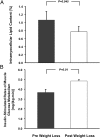Reversal of muscle insulin resistance by weight reduction in young, lean, insulin-resistant offspring of parents with type 2 diabetes
- PMID: 22547801
- PMCID: PMC3361376
- DOI: 10.1073/pnas.1205675109
Reversal of muscle insulin resistance by weight reduction in young, lean, insulin-resistant offspring of parents with type 2 diabetes
Abstract
To examine the role of intramyocellular lipid (IMCL) accumulation as well as circulating cytokines, branched-chain amino acids and acylcarnitines in the pathogenesis of muscle insulin resistance in healthy, young, lean insulin-resistant offspring of parents with type 2 diabetes (IR offspring), we measured these factors in plasma and used (1)H magnetic resonance spectroscopy to assess IMCL content and hyperinsulinemic-euglycemic clamps using [6,6-(2)H(2)] glucose to assess rates of insulin-stimulated peripheral glucose metabolism before and after weight reduction. Seven lean (body mass index < 25 kg/m(2)), young, sedentary IR offspring were studied before and after weight stabilization following a hypocaloric (1,200 Kcal) diet for ∼9 wks. This diet resulted in an average weight loss of 4.1 ± 0.6 kg (P < 0.0005), which was associated with an ∼30% reduction of IMCL from 1.1 ± 0.2% to 0.8 ± 0.1% (P = 0.045) and an ∼30% improvement in insulin-stimulated muscle glucose uptake [3.7 ± 0.3 vs. 4.8 ± 0.1 mg/(kg-min), P = 0.01]. This marked improvement in insulin-stimulated peripheral insulin responsiveness occurred independently of changes in plasma concentrations of TNF-α, IL-6, total adiponectin, C-reactive protein, acylcarnitines, and branched-chain amino acids. In conclusion, these data support the hypothesis that IMCL accumulation plays an important role in causing muscle insulin resistance in young, lean IR offspring, and that both are reversible with modest weight loss.
Conflict of interest statement
The authors declare no conflict of interest.
Figures
References
-
- Lillioja S, et al. Impaired glucose tolerance as a disorder of insulin action. Longitudinal and cross-sectional studies in Pima Indians. N Engl J Med. 1988;318:1217–1225. - PubMed
-
- Lillioja S, et al. Insulin resistance and insulin secretory dysfunction as precursors of non-insulin-dependent diabetes mellitus. Prospective studies of Pima Indians. N Engl J Med. 1993;329:1988–1992. - PubMed
-
- Warram JH, Martin BC, Krolewski AS, Soeldner JS, Kahn CR. Slow glucose removal rate and hyperinsulinemia precede the development of type II diabetes in the offspring of diabetic parents. Ann Intern Med. 1990;113:909–915. - PubMed
-
- Zimmet P, Alberti KG, Shaw J. Global and societal implications of the diabetes epidemic. Nature. 2001;414:782–787. - PubMed
Publication types
MeSH terms
Substances
Grants and funding
LinkOut - more resources
Full Text Sources
Other Literature Sources
Medical
Research Materials


